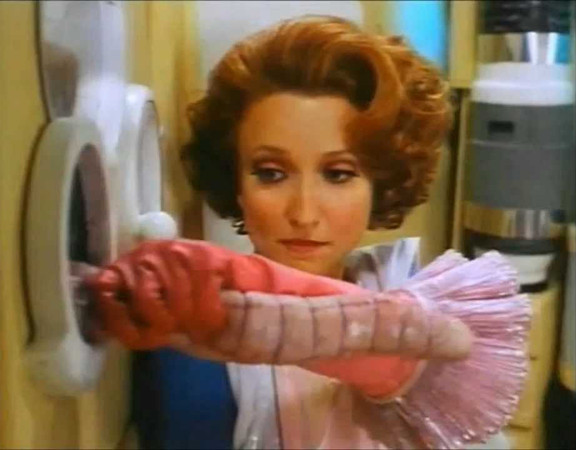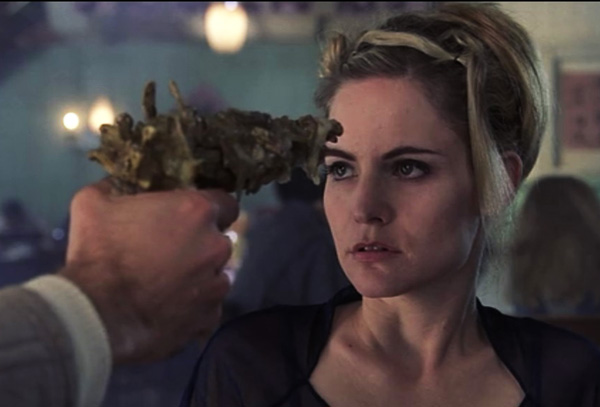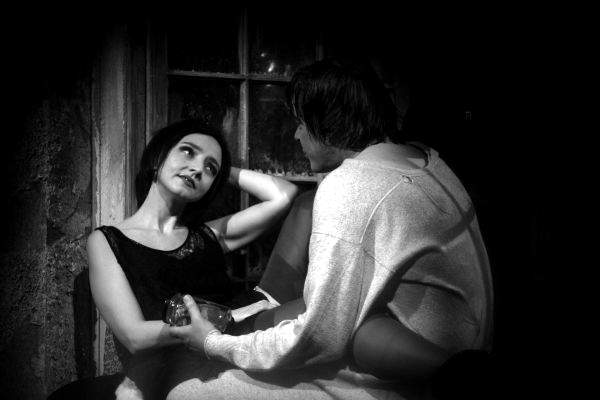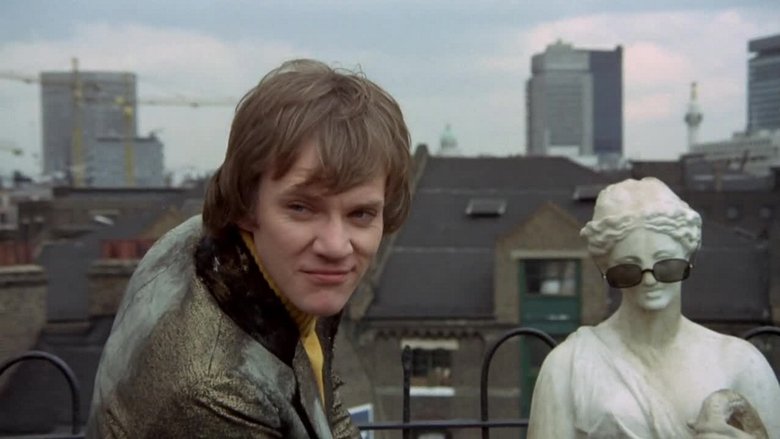6. Titus

William Shakespeare, The Bard Of Avon, wrote some of the finest plays in history, ones that poetically expound upon the nature of love, life, and mortality. But early in his career, the eventual author of such immortal classics like Hamlet and Romeo & Juliet was trying to make a name for himself and emulated the popular Jacobean tragedies of the late 16th century, which were filled with bloody revenge and bizarre acts of violence.
First performed in 1592, Shakespeare’s Titus Andronicus details the escalating cycle of revenge between the titular character, a Roman general, and the defeated Tamora, Queen of the Goths. Featuring rape, dismemberment, scores of murders, and matriarchal cannibalism, it was wildly popular in its time, but its reputation–and later critical reevaluations of Shakespeare’s oeuvre–now place this play as one of The Bard’s lesser works.
This didn’t deter director Julie Taymor–fresh off her success of directing Broadway’s innovative The Lion King–from adapting the play as her directorial debut. Released in 1999, Titus–starring Anthony Hopkins as the titular character and Jessica Lange as Tamora–was a box office bomb, recovering only 10% of its $25 million budget.
However, it is a fascinating movie filled with striking visuals that show off Taymor’s flair for choreography and eye for dynamic costume and set design. It is also notable for reproducing one of Shakespeare’s least-popular plays (to contemporary audiences, at least), providing students and scholars an accessible adaptation of one of his earliest–and oddest–works.
And, of course, its plot follows the bloody, violent, and amoral revenge tale originally written over 400 years earlier. More obscure than hard-to-find, it is still a relatively unknown and very strange film.
7. Meet The Hollowheads

Think of a post-apocalyptic Father Knows Best and you’re almost there. Add an underground society dependent on a system of tubes that provide everything from food to sex jelly (don’t ask; you won’t be provided an answer, anyway) and mutant creatures that are kept in kitchen cabinets and are used for their both their healing properties and as another source of food, and it’s still not quite everything that encompasses the bizarre world of Meet The Hollowheads.
In its simplest form, the plot is as follows: a happy homemaker and her devoted, hardworking husband prepare for dinner with his boss while trying to manage their three children–two teenagers preparing to go to a party that evening and an irascible young son who gets into all sorts of hijinks around the house. It could be a description of any typical 1950’s sitcom–but that’s where the similarities end.
As a satire, it’s difficult to discern what’s being satirized in the film, as every identifiable touchstone of what we consider normal–family, home life, society, reality itself–is twisted and subverted in the highly stylized (and often left unexplained) world of Meet The Hollowheads.
Think Brazil by way of Leave It to Beaver that inhabits the weird world of The 5000 Fingers of Dr. T. The only film directed by Thomas R. Burman (a make-up artist who had worked on dozens of well-known sci-fi films, including Planet of the Apes, Close Encounters of the Third Kind, and the 1978 remake of Invasion of the Body Snatchers), his eye-popping stylized visual effects are on full display in this film.
It’s a one-of-a-kind movie that teeters between being a Cronenberg horror film and pitch-black comedy. While it tanked upon release in 1989, today it enjoys an appreciative (if small) cult following.
8. eXistenZ

David Cronenberg is known for being one of the godfathers of weird cinema: having perfected the genre of body horror with such works as Scanners, The Fly, and Videodrome. eXistenZ–released in 1999–was a spiritual sequel to the latter, which details the efforts of video game designer Allegra Geller (Jennifer Jason Leigh) whose virtual reality game (the titular eXistenZ) is being subject to a hostile corporate takeover.
While this seems straightforward enough, the methods by which one plays the game is pure Cronenberg: an open “bio port” is drilled into the base of a player’s spine, into which a “game pod”–a biological creature whose tentacle is inserted into said bio port–transports the player into the game. Joining her is an agent from the corporation named Pikel (Jude Law), who is a novice to the gaming system.
As much a statement on the effect of technology on human psychology, the depiction of this–where living organisms act as biotechnology and all-encompassing virtual reality systems blur the line between the real world and an artificial one–is filled with grotesque depictions of intrusive body manipulation and mutant creatures affecting both the real world and the virtual one.
Heady topics such as free will and the nature of reality are explored throughout a film that begins to make the viewer question whether what they are watching is “real” or just part of the game.
Upon release, eXistenZ was well-received but performed poorly at the box office. Its growing cult status in the intervening years suggests that it was perhaps ahead of its time; gaming and virtual reality technologies have progressed significantly since the late 1990’s, and the elements of the film that once seemed far-fetched then have become increasingly more plausible with each passing year.
Although not difficult to find, it’s not often highlighted when Cronenberg’s body of work is written about, even though (aside from Videodrome) it’s possibly his weirdest film, remaining a relatively obscure entry from an acclaimed director.
9. The Saddest Music In The World

Guy Maddin is perhaps the contemporary cultist’s cult director: this Canadian filmmaker makes anti-modern films that share the aesthetic of expressionist films and the sensibilities of The Elephant Man-era David Lynch. Although his films are obscure to most audiences outside of Canada, The Saddest Music In The World is both his most bizarre and accessible to a novice of his work.
To wit: the plot involves a legless beer baroness, a dysfunctional family of men whose sons form a love triangle with an amnesiac nymphomaniac, and a pair of glass legs fashioned by the father filled with beer for said legless baroness, who is his long-lost love.
The beer baroness (played by Isabella Rossellini) is holding a contest in Depression-era Winnepeg for “The Saddest Music In The World.” All three men from this family enter the contest, and although they are all Canadian, the sons represent foreign countries (one for America, and the other for Serbia).
Also, one of the sons was previously married to the amnesiac, who lost her memory after their child died and is now with the other son; in contrast, the bereaved son carries his boy’s heart around in a glass jar.
It’s a weird setup to a highly stylized film that looks like a film that was made 60 years before its actual production. Strange and artful, bizarre yet sentimental, this film only received limited release in theaters outside of Canada before being released on the home market.
After The Saddest Music In The World, Maddin has continued to make his distinct brand of weird cinema by making smaller films, producing installation pieces for art galleries, and publishing a handful of books, but has yet to create another film as ambitious and complex as this one. Although not well-known, it is readily available on DVD, waiting to be uncovered by any cinephile looking for a diamond in the Canadian rough.
10. O Lucky Man!

Lindsay Anderson is a highly regarded director even though he only made 9 feature films in his lifetime. While some are regarded as classics, such as This Sporting Life (1963) and If… (1968), much of his work has fallen into obscurity. Perhaps his masterpiece, the 3-hour-long epic O Lucky Man! (1973) follows the adventures of coffee salesman Mick Travis (played by Malcolm McDowell, who was reprising his role from If…) and his adventures in capitalist society.
The film plays like a dream, with Travis traveling from one surreal episode to the next: at one moment, he’s being seduced by a lonely border and is presented a golden suit to wear during his sales calls; the next, he’s abducted for experimentation by a mad scientist; and then, thanks to a man who somewhat randomly falls out of a window, he’s immediately promoted to being the assistant to a prominent businessman; and before the film is through, he’s cast as the star of the very movie that you’re watching.
All of this is accompanied by a soundtrack by The Animals’ Alan Price, whose sardonic lyrics act as a greek chorus to the action (at one point Mick Travis hitches a ride with Price and his band because it’s that kind of movie).
While the length of the film may deter some from watching it, there has simply been no other film made like this that works as an allegory for life in capitalist society. In equal parts a comedy, drama, fantasy, musical, and adventure film, the sheer scope of Anderson’s cinematic vision is impressive.
As mentioned, the soundtrack is unique and provides catchy, ironic pop songs on esoteric concepts such as justice, how to succeed in business, and why people are poor. The film received middling reviews upon release and performed poorly at the box office (its prohibitive running time being a factor in this), but general consensus since now views the film favorably, regarding it as an odd, one-of-a-kind cult film.
This film and its follow-up (1982’s equally satirical but even more obscure Britannia Hospital) completes the “Mick Travis trilogy” that started in If… that Anderson envisioned for the character. A two-disc DVD was released in 2007 and is available for rental and purchase on some streaming services, but O Lucky Man! is rarely (if ever) shown on television due to its considerably length.
Author Bio: Mike Gray is a writer, editor, and academic from the Jersey Shore. His work has been featured on Cracked and Funny or Die, and he maintains a humor recap film blog at mikegraymikegray.wordpress.com.